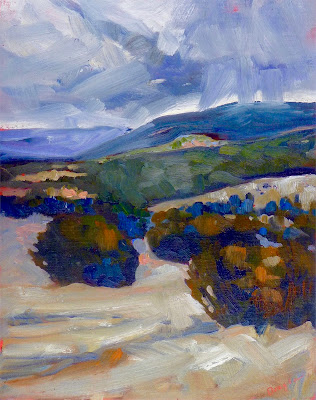It’s what you bring to it. That’s true in life as much as in painting.
 |
| A wee little demo I did of water tumbling over rocks. I’m using the same watercolor kit as my students will use next week aboard American Eagle. |
This week I’m on a ranch high above Pecos, NM. The owners and the cloud of dogs who usually trail after them are elsewhere. It’s just me, three horses and a donkey. “Aren’t you worried about being alone out there?” one of my workshop students asked me. No.
I had horses when I was young but it’s been a long time since I’ve handled them closely. They set a rhythm to my day. I block out time in the morning and evening to attend to them. Among the pinon and dust of a New Mexico September, I have long stretches of absolute silence. That’s a rarity in the modern world.
 |
| Donna finds serenity in the Pecos River. |
We don’t form as tight a bond with horses as we do with our dogs, but the potential is there. In 1910 there were about 20 million domestic horses in North America, or around one for every six people. They lived and worked side-by-side with their humans with an intimacy we can’t imagine today.
The owner of Scout, Lucy, Duke and Jimmy (the donkey) is a tiny woman, but she bosses them with impunity. She’s their alpha human. I’m a stranger. Inevitably, like children, they had to test me.
The monkey business started on Tuesday evening, when I came out of the tackroom with an armful of hay to be mugged by the two geldings and a donkey. I’m half a foot taller and sixty pounds heavier than Jane, and I could not push those knuckleheads out of my way. They leaned on me, inevitably getting me to drop their supper. After I’d retrieved and separated it, they started fussing at each other.
 |
| Yves painting in the historic barrio of Santa Fe. |
Duke bit Jimmy, and Jimmy kicked out at anyone who was nearby. I yelled. Jimmy laid back his ears, stuck out his lip, and brayed. He looked so much like an angry toddler that I started laughing. “I don’t know which one of you started it,” I yelled, “but you’re all grounded!” At that moment they reminded me powerfully of my own children back in the day.
The horses outweigh me, but I have an advantage: my opposable thumbs. On Wednesday, I scarpered out the back and around to the other side of their corral, where I distributed their hay before they realized where I was. Peace has reigned ever since in the Horse Kingdom.
 |
| I’ll horse-sit these darlings any time! |
I love this place, but that doesn’t lessen my appreciation for my own home in Maine, or my workshop aboard American Eagle, which starts Sunday. Would I be this happy in a flat in a rust-belt city? It’s been almost forty years since I’ve lived that life, but I hope so.
I do an exercise with my workshop students where I ask them to paint a scene chosen by committee. It’s not the subject that makes the painting, it’s what they bring to it. That’s true of life as well. Obviously, crisis and grief are exceptions; we all go through seasons of loss, and we’re not expected to be happy in them. But in the general run of events, we are designed for happiness. If it eludes us, it behooves us to figure out why—and to fix it.
No blog next week, because there’s no internet on Penobscot Bay. Please, techies, never fix that!










































